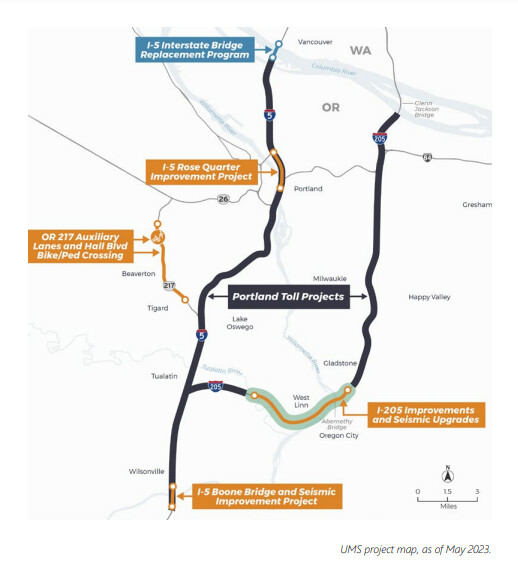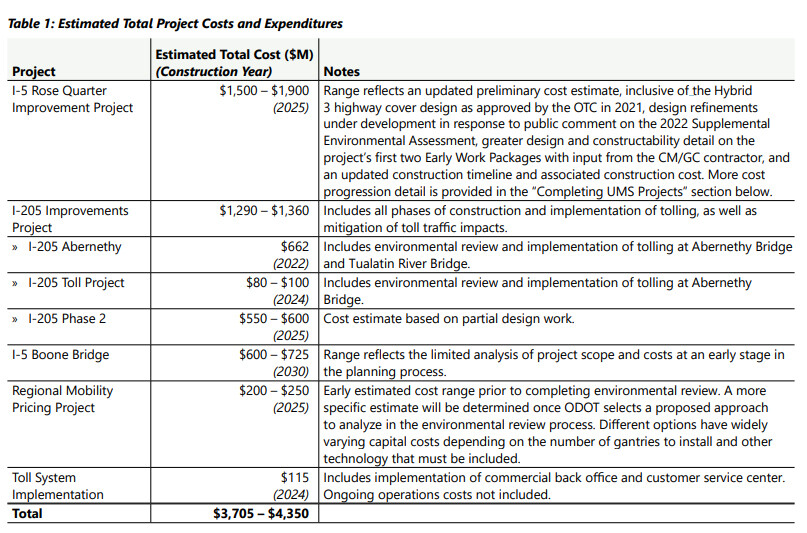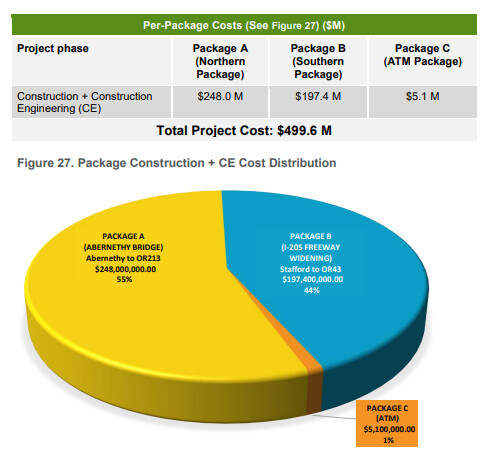Tolling pause is only $200 million of ODOT funding hole
John Ley
For Clark County Today
One day after the Oregon legislature ended its historic session, the head of the Oregon Department of Transportation (ODOT) officials announced the delay or possible downsizing of three major transportation projects in the Portland area. Kris Strickler told the Regional Tolling Advisory Committee (RTAC) on Monday that his agency needed between $3.7 and $4.3 billion to cover projects in their Urban Mobility Strategy (UMS) finance plan. They expect $1.1 billion to come from tolling.
The plan will pause or downsize the I-5 Rose Quarter project which will add two auxiliary lanes south of the Fremont Bridge through where I-84 merges with I-5. ODOT also wants to postpone the planned addition of a 7-mile lane to I-205 between the Abernethy Bridge and Stafford Road. Additionally, they’ll pause the planned replacement of the Wilsonville Boone Bridge on I-5, which was to include adding an auxiliary lane.
After a similar presentation to the Oregon Transportation Commission (OTC) on Wednesday, the ODOT recommendations will be forwarded to Oregon Gov. Tina Kotek.
“We proposed a baseline and two alternatives that each move the project forward,” ODOT said in a press release.. “Each option identified a level of funding and the expected level of design work that could be completed with that funding. No options included funding for construction as that level of funding is not currently available to the agency.”
The roughly $3 billion ODOT funding shortfall contrasts sharply with the legislature having allocated record levels of money for all state government agencies. Oregon’s Constitutional “kicker” mandates the return of an expected $5.5 billion to Oregon taxpayers later this year.
This is of vital interest for Clark County and Southwest Washington residents because over 75,000 people north of the Columbia River earn a paycheck in Oregon. Columbia River bridge crossings have nearly returned to pre-pandemic levels.
Besides tolls for the Interstate Bridge Replacement (IBR) structure, Oregon is planning “per mile” tolls for every highway and freeway in the Portland metro area as part of their UMS plan. Economist Joe Cortright revealed daily round trip tolls could be as much as $28 to $31 dollars when traveling from Vancouver to Wilsonville.

Strickler told the RTAC members they had expected $1.3 billion in revenues from tolling. But when Kotek issued an executive order pausing tolling by about 18 months, that will reduce expected revenues by $200 million. The Oregon legislature did not pass any new taxes for transportation, but instead allocated $250 million in general fund revenue as a downpayment for the IBR.
The UMS financial plan highlighted continued escalating costs for the regional transportation projects. The Rose Quarter project was originally estimated to cost $450 million when the legislature passed HB 2017 six years ago, allocating $5.3 billion for statewide transportation projects. The Rose Quarter is now estimated to cost between $1.5 billion to $1.9 billion, approaching four times the original ODOT estimate.
The I-205 Abernethy Bridge seismic upgrade and widening presently underway will be completed. However the addition of two lanes to I-205 (one in each direction) will be paused. ODOT lists the total project costs now at $1.29 to $1.36 billion. This is nearly triple the original HB 2017 projections.
The I-5 Boone Bridge replacement project has a cost projection of $600-$725 million (2030 dollars).
ODOT estimates costs for adding tolling to be $80-$100 million in 2024. They further expect an additional $115 million for “toll system implementation” in 2024. To date, they have spent $339 million on the UMS projects.
None of this takes into account the possible impact of citizen initiative IP-4. This would give citizens the right to vote before tolling could be implemented on any Oregon highway. Dean Suhr says it is retroactive and would include the Interstate Bridge project as well as all projects currently being discussed.
IP-4 is a Constitutional amendment, so legislators or the governor can’t make unilateral revisions without the approval of the people. The Vote Before Tolls group is seeking to collect 200,000 Oregon voter signatures by June 2024 to put the issue on the November 2024 ballot.
As originally proposed, ODOT told citizens the I-205 Abernethy Bridge project would eliminate 12 hours of traffic congestion. Now that the 7-mile stretch of a new third lane on I-205 is on hold, it is unclear how much, if any reduction in traffic congestion there will be.

With the Rose Quarter project at least temporarily on hold, it is unclear what impact that will have on the I-5 traffic and the IBR. Administrator Greg Johnson’s team has told the community that in 2045, there would be improvements in northbound travel times, but morning southbound travel times would double. But those predictions assumed completion of the Rose Quarter project with its two auxiliary lanes. It is likely all travel times will be worse in 2045 without the added auxiliary lanes at the Rose Quarter.
During the RTAC meeting, Jana Jarvis of the Oregon Trucking Association told the committee that ODOT took its eye off their main job – building a transportation system. She noted ODOT appears to be moving away from a user pays system (gas tax) to one based on income levels, as low and middle income users get free or reduced fees (tolls) for driving on the freeways.
Clackamas County Commissioner Paul Savas spoke about all the traffic diversion problems the I-205 tolling will create. He noted an Atlanta official told them “we don’t have a diversion problem in Atlanta.” They have express (tolled) lanes as well as free lanes for people to choose from. Savas concluded by saying “we’re creating problems we don’t need to create”.
C-TRAN CEO Shawn Donaghy mentioned cities are creating road diets (eliminating lanes) but that tolling will increase diversion onto those same roads. Metro’s Lynn Peterson wanted to know what problems are attributable to tolling and what problems can be attributed to other issues? There was no answer to her question.
Originally, HB 2017 approved $5.3 billion in transportation spending and also asked ODOT to “study” tolling. Four years later, HB 3055 authorized tolling.
But ODOT created the beginnings of the current funding shortfall crisis. It failed to include inflation adjustments to the cost of projects given to the legislature in 2017. After the legislation became law, they admitted the error and hundreds of millions were added to the cost estimates. Cortright described ODOT management a “reign of error” a year ago as costs continued to escalate.
An additional challenge surfaced in discussions about the Rose Quarter project. Originally ODOT officials had proposed two separate “lids” over I-5, which allowed them to avoid Federal Highway Administration requirements if a “tunnel” were created with a single, larger lid. But discussions with north Portland minority representatives resulted in a single, larger lid over I-5 being proposed. The Albina community then succeeded in lobbying for a structure that would allow for five- or six-story buildings to be constructed on the freeway lid, adding to the cost.
For citizens all around the Portland metro area, and especially for Clark County residents who work in Oregon, the huge escalating costs of these projects begs the question of who will pay and will people get an improved transportation system that saves them travel time?

Also read:
- Opinion: Hiding the growing cost of the Interstate Bridge replacementJoe Cortright of the City Observatory addresses the rising cost of the Interstate 5 Bridge replacement project.
- 90 minutes of delay on Southbound I-5 in Southwest Washington on Friday afternoon, July 26Travelers using southbound Interstate 5 through Woodland should expect up to 90 minutes of delay during Friday afternoon and evening and should delay travel or prepare for additional travel time.
- Nighttime paving work on I-5 and SR 14 in Clark County July 28-Aug. 9Nighttime travelers in Clark County should expect delays for maintenance and paving work beginning Sunday, July 28 until the morning of Friday, Aug. 9.
- Northeast 182nd Avenue/Northeast Ward Road to be closed on Aug. 1Northeast 182nd Avenue and Northeast 172nd Avenue in Clark County will have single-day closures on August 1 and August 5 for road preservation, with detours in place.
- Interstate Bridge Replacement program awarded $1.499 billion FHWA Bridge Investment Program grantInterstate Bridge Replacement program officials have shared that the program received $1.499 billion through the Federal Highway Administration’s Bridge Investment Program.









